-

新人教版高中英语选修2Unit 3 Learning about Language教学设计
1. We'll need ten months at least to have the restaurant decorated.2.Some traditional Chinese dishes from before the Ming Dynasty are still popular today.3.My grandpa's breakfast mainly includes whole grain biscuits and a glass of milk.4.People in this area would eat nearly a kilo of cheese per week.5. We enjoyed a special dinner in a fancy restaurant where the waiters all wore attractive suits.6. He prefers this brand of coffee which, as he said, has an unusually good flavor.Key:1. at a minimum 2. prior to3. consist of4. consume5. elegant6. exceptionalStep 5:Familiarize yourself with some food idioms by matching the meaning on the right with the colored words on the left.1.Public concern for the health of farm animals has mushroomed in the UK2.Anderson may be young but he's certainly rolling to doing dough!3.George is a popular lecturer. He often peppers his speech with jokes.4.As the person to bring home the bacon, he needs to find a stable job.5 He is often regarded as a ham actor for his over emphasized facial expressions. The media reported that these companies had treated pollution as a hot potato. 6.The media reported that these companies had treated pollution as a hot potato.7.Don't worry about the test tomorrow. It's going to be a piece of cake!8. It's best to fold the swimming ring when it is as flat as a pancake.A. completely flatB. something that is very easy to do C.an issue that is hard to deal withD.to include large numbers of somethingE.to earn on e's living to support a familyF. wealthyG.to rapidly increase in numberH. an actor who performs badly, especially by over emphasizing emotions

新人教版高中英语选修2Unit 2 Learning about Language教学设计
The activity theme of this section is to design various activities around the key words in the first text. Therefore, the activities require students to pay attention to the spelling of words. On the other hand, let students grasp the meaning of words more accurately through sentences and short texts. This kind of teaching design also helps to improve the ability of using English thinking.1. Cultivating students' ability to use word formation to induce and memorize vocabulary, and the ability to use lexical chunks to express meaning.2. Guide the students to think independently and use the correct form of words to complete sentences3. Cultivate students' habit of using lexical chunks to express language completely, guide students to draw words in sentences quickly, pay attention to word collocation, so as to accumulate more authentic expressions4. Instruct students to create sentences with the chunks.1. Enable students to use the language points in the real situation or specific contexts flexibly and appropriately.2. Guiding the Ss to use unit topic words and the sentence patterns in a richer context.Step1: Think of a word that best fits each definition.1. to remember sth2.to accept, admit, or recognize sth or the truth/existence of sth3. the process of changing sth or yourself to suit a new situation4 .to make sb feel less worried or unhappy5. a strong desire to achieve sth

新人教版高中英语选修2Unit 5 Reading for writing教学设计
你校英语报计划出版一期急救常识专刊,现面向全校学生公开征集稿件,你有意参加。请你根据下面提示内容,用英语写一篇短文,介绍在车祸现场对伤者进行急救的方法和步骤。1.确保现场的安全;2.询问伤者,确保其呼吸正常;3.检查伤口,如流血则应采取止血措施;4.如需急救,确保其处于康复位置。注意:1.词数80左右;2.可以适当增加细节,以使行文连贯。参考词汇:康复位置 recovery positionAs we all know, having a knowledge of first aid can make a great difference in our daily life. If a traffic accident happens and someone is injured, the following steps can be used to treat the injured.In the first place, we should make sure that the accident scene is safe so that we won’t get hurt. We should ask the injured person if he is OK, and see if he is breathing. What’s more, we should check for cuts and wounds. If he is bleeding badly, it is vital that we should try to stop the bleeding by applying pressure to the injury. This is because if a person loses too much blood, he may die. If necessary, take the injured person to the hospital as soon as possible.Do remember: when giving first aid, please be sure to place the person in a recovery position.

新人教版高中英语选修2Unit 3 Reading for writing教学设计
The theme of this part is to write an article about healthy diet. Through reading and writing activities, students can accumulate knowledge about healthy diet, deepen their understanding of the theme of healthy diet, and reflect on their own eating habits. This text describes the basic principles of healthy diet. The author uses data analysis, definition, comparison, examples and other methods. It also provides a demonstration of the use of conjunctions, which provides important information reference for students to complete the next collaborative task, writing skills, vivid language materials and expressions.1. Teach Ss to learn and skillfully use the new words learned from the text.2. Develop students’ ability to understand, extract and summarize information.3. Guide students to understand the theme of healthy diet and reflect on their own eating habits.4. To guide students to analyze and understand the reading discourse from the aspects of theme content, writing structure, language expression, etc., 5. Enable Ss to write in combination with relevant topics and opinions, and to talk about their eating habits.1. Guide students to analyze and understand the reading discourse from the aspects of theme content, writing structure, language expression, etc.2. Enable them to write in combination with relevant topics and opinions, and to talk about their eating habits.3. Guide the students to use the cohesive words correctly, strengthen the textual cohesion, and make the expression fluent and the thinking clear.Step1: Warming upbrainstorm some healthy eating habits.1.Eat slowly.2.Don’t eat too much fat or sugar.3.Eat healthy food.4.Have a balanced diet.Step2: Read the passage and then sum up the main idea of each paragraph.

新人教版高中英语选修2Unit 2 Reading for writing教学设计
The theme of this section is to express people's views on studying abroad. With the continuous development of Chinese economic construction, especially the general improvement of people's living standards, the number of Chinese students studying abroad at their own expense is on the rise. Many students and parents turn their attention to the world and regard studying abroad as an effective way to improve their quality, broaden their horizons and master the world's advanced scientific knowledge, which is very important for the fever of going abroad. Studying abroad is also an important decision made by a family for their children. Therefore, it is of great social significance to discuss this issue. The theme of this section is the column discussion in the newspaper: the advantages and disadvantages of studying abroad. The discourse is about two parents' contribution letters on this issue. They respectively express their own positions. One thinks that the disadvantages outweigh the advantages, and the other thinks that the advantages outweigh the disadvantages. The two parents' arguments are well founded and logical. It is worth noting that the two authors do not express their views on studying abroad from an individual point of view, but from a national or even global point of view. These two articles have the characteristics of both letters and argumentative essays1.Guide the students to read these two articles, and understand the author's point of view and argument ideas2.Help the students to summarize the structure and writing methods of argumentative writing, and guides students to correctly understand the advantages and disadvantages of studying abroad3.Cultivate students' ability to analyze problems objectively, comprehensively and deeply

新人教版高中英语选修2Unit 4 Learning about Language教学设计
This section guides students to pay attention to the typical context of vocabulary use, helps students accumulate vocabulary around the key vocabulary of this unit, and uses the learned words and word chunks in different contexts to deeply understand their meaning and usage, so as to achieve the purpose of review and consolidation.The teaching design activities aim to guide students to pay attention to the typical context in which the target vocabulary is used, as well as the common vocabulary used in collocation, so that students can complete the sentence with correct words. In terms of vocabulary learning strategies, this unit focuses on cultivating students' ability to pay attention to collocation of words and to use word blocks to express meaning.For vocabulary learning, it is not enough just to know the meaning of a single word, but the most important thing is to master the common collocations of words, namely word blocks.Teachers should timely guide students to summarize common vocabulary collocation, such as verb and noun collocation, verb and preposition collocation, preposition and noun collocation, and so on.1. Guide students to understand and consolidate the meaning and usage of the vocabulary in the context, 2. Guide the students to use the unit topic vocabulary in a richer context3. Let the students sort out and accumulate the accumulated vocabulary, establishes the semantic connection between the vocabulary,4. Enable students to understand and master the vocabulary more effectivelyGuiding the Ss to use unit topic words and the sentence patterns in a richer context.

新人教版高中英语选修2Unit 4 Reading for writing教学设计
假定你是英国的Jack,打算来中国旅行,请你给你的中国笔友李华写一封信,要点如下:1.你的旅行计划:北京→泰山→杭州;2.征求建议并询问他是否愿意充当你的导游。注意:1.词数80左右(开头和结尾已给出,不计入总词数);2.可以适当增加细节,以使行文连贯。参考词汇:故宫 the Forbidden City;泰山 Mount TaiDear Li Hua,I'm glad to tell you that 'm going to visit China.First,I am planning to visit Beijing,the capitalof China,where I am looking forward to enjoying the Great Wall,the Forbidden City and somebeautiful parks.Then I intend to go to visit Mount Tai in Shandong Province.I've heard that it is one ofthe most famous mountains in China and I can't wait to enjoy the amazing sunrise there.After that,I amalso going to Hangzhou.It is said that it is a beautiful modern city with breathtaking natural sights,among which the West Lake is a well- known tourist attraction.What do you think of my travel plan? Will you act as my guide? Hope to hear from you soon.

新人教版高中英语选修2Unit 4 Using langauge-Listening教学设计
The theme of the listening section is " talking about scenery and culture along a journey."The part is designed to further lead the students to understand Canadian natural geography and social environment, and integrated into the cultural contrast by mentioning the long train journey from Beijing to Moscow routes. On this basis, the part activates students related travel experience, lets the student serial dialogue, guides the student to explore further the pleasure and meaning of the long journey, and Chinese and foreign cultural comparison.The part also provides a framework for the continuation of the dialogue, which is designed to provide a framework for students to successfully complete their oral expressions, and to incorporate an important trading strategy to end the dialogue naturally.1. Help students to understand and master some common English idioms in the context, and experience the expression effect of English idioms.2. Guide the students to understand the identity of different people in the listening context, and finish the dialogue according to their own experience.3. Instruct the students to use appropriate language to express surprise and curiosity about space and place in the dialogue, and master the oral strategy of ending the dialogue naturally.1. Instruct students to grasp the key information and important details of the dialogue.2. Instruct students to conduct a similar talk on the relevant topic.

新人教版高中英语选修2Unit 5 Learning about Language教学设计
The purpose of this section of vocabulary exercises is to consolidate the key words in the first part of the reading text, let the students write the words according to the English definition, and focus on the detection of the meaning and spelling of the new words. The teaching design includes use English definition to explain words, which is conducive to improving students' interest in vocabulary learning, cultivating their sense of English language and thinking in English, and making students willing to use this method to better grasp the meaning of words, expand their vocabulary, and improve their ability of vocabulary application. Besides, the design offers more context including sentences and short passage for students to practice words flexibly.1. Guide students to understand and consolidate the meaning and usage of the vocabulary in the context, 2. Guide the students to use the unit topic vocabulary in a richer context3. Let the students sort out and accumulate the accumulated vocabulary, establishes the semantic connection between the vocabulary,4. Enable students to understand and master the vocabulary more effectivelyGuiding the Ss to use unit topic words and the sentence patterns in a richer context.Step1: Read the passage about chemical burns and fill in the blanks with the correct forms of the words in the box.

新人教版高中英语选修2Unit 5 Reading and thinking教学设计
The theme of this activity is to learn the first aid knowledge of burns. Burns is common in life, but there are some misunderstandings in manual treatment. This activity provides students with correct first aid methods, so as not to take them for granted in an emergency. This section guides students to analyze the causes of scald and help students avoid such things. From the perspective of text structure and collaborative features, the text is expository. Expository, with explanation as the main way of expression, transmits knowledge and information to readers by analyzing concepts and elaborating examples. This text arranges the information in logical order, clearly presents three parts of the content through the subtitle, accurately describes the causes, types, characteristics and first aid measures of burns, and some paragraphs use topic sentences to summarize the main idea, and the level is very clear.1. Guide students to understand the causes, types, characteristics and first aid methods of burns, through reading2. Enhance students’ ability to deal withburnss and their awareness of burns prevention3. Enable students to improve the ability to judge the types of texts accurately and to master the characteristics and writing techniques of expository texts.Guide students to understand the causes, types, characteristics and first aid methods of burns, through readingStep1: Lead in by discussing the related topic:1. What first-aid techniques do you know of ?CPR; mouth to mouth artificial respiration; the Heimlich Manoeuvre

新人教版高中英语选修2Unit 5 Using langauge-Listening教学设计
The theme of this section is to learn how to make emergency calls. Students should learn how to make emergency calls not only in China, but also in foreign countries in English, so that they can be prepared for future situations outside the home.The emergency telephone number is a vital hotline, which should be the most clear, rapid and effective communication with the acute operator.This section helps students to understand the emergency calls in some countries and the precautions for making emergency calls. Through the study of this section, students can accumulate common expressions and sentence patterns in this context. 1.Help students accumulate emergency telephone numbers in different countries and learn more about first aid2.Guide the students to understand the contents and instructions of the telephone, grasp the characteristics of the emergency telephone and the requirements of the emergency telephone.3.Guide students to understand the first aid instructions of the operators.4.Enable Ss to make simulated emergency calls with their partners in the language they have learned1. Instruct students to grasp the key information and important details of the dialogue.2. Instruct students to conduct a similar talk on the relevant topic.Step1:Look and discuss:Match the pictures below to the medical emergencies, and then discuss the questions in groups.
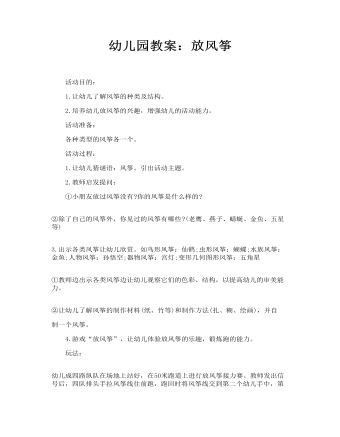
幼儿园教案:放风筝
活动过程: 1.让幼儿猜谜语:风筝。引出活动主题。 2.教师启发提问: ①小朋友放过风筝没有?你的风筝是什么样的? ②除了自己的风筝外,你见过的风筝有哪些?(老鹰、燕子、蜻蜒、金鱼、五星等)
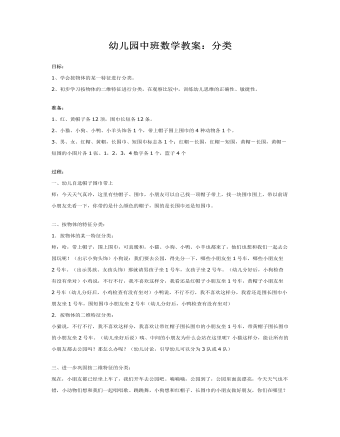
幼儿园中班数学教案:分类
准备: 1、红、黄帽子各12顶,围巾长短各12条。 2、小猫、小狗、小鸭、小羊头饰各1个,带上帽子围上围巾的4种动物各1个。 3、男、女、红帽、黄帽,长围巾、短围巾标志各1个;红帽-长围,红帽-短围,黄帽-长围,黄帽-短围的小图片各1张。1,2,3,4数字各1个,篮子4个过程: 一、幼儿自选帽子围巾带上 师:今天天气真冷,这里有些帽子、围巾,小朋友可以自己找一顶帽子带上,找一块围巾围上,带以前请小朋友先看一下,你带的是什么颜色的帽子,围的是长围巾还是短围巾。二、按物体的特征分类: 1.按物体的某一特征分类: 师:哈,带上帽子,围上围巾,可真暖和。小猫、小狗、小鸭、小羊也都来了,他们也想和我们一起去公园玩呢!(出示小狗头饰)小狗说:我们要去公园,得先分一下,哪些小朋友坐1号车,哪些小朋友坐2号车。(出示男孩、女孩头饰)那就请男孩子坐1号车,女孩子坐2号车。(幼儿分好后,小狗检查有没有坐对)小鸡说,不行不行,我不喜欢这样分,我看还是红帽子小朋友坐1号车,黄帽子小朋友坐2号车(幼儿分好后,小鸡检查有没有坐对)小鸭说,不行不行,我不喜欢这样分,我看还是围长围巾小朋友坐1号车,围短围巾小朋友坐2号车(幼儿分好后,小鸭检查有没有坐对)
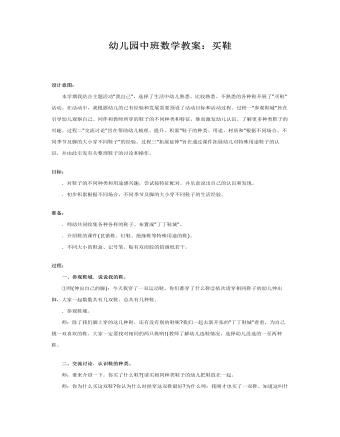
幼儿园中班数学教案:买鞋
目标: .对鞋子的不同种类和用途感兴趣,尝试按特征配对。并乐意说出自己的认识和发现。 .初步积累根据不同场合、不同季节及脚的大小穿不同鞋子的生活经验。准备: .师幼共同收集各种各样的鞋子。布置成"丁丁鞋城"。 .介绍鞋的课件(芭蕾鞋、钉鞋、绝缘鞋等特殊用途的鞋)。 .不同大小的鞋盒、记号笔、贴有双而胶的铅画纸若干。过程: 一、参观鞋城.说说我的鞋。①师(伸出自己的脚):今天我穿了一双运动鞋。你们都穿了什么鞋②依次请穿相同鞋子的幼儿伸出脚,大家一起数数共有几双鞋。总共有几种鞋。 .参观鞋城。 师:除了我们脚上穿的这几种鞋.还有没有别的鞋呢?我们一起去新开张的"丁丁鞋城"看看,为自己挑一双喜欢的鞋。大家一定要找对相同的两只鞋哟!(教师了解幼儿选鞋情况,选择幼儿没选的一至两种鞋。
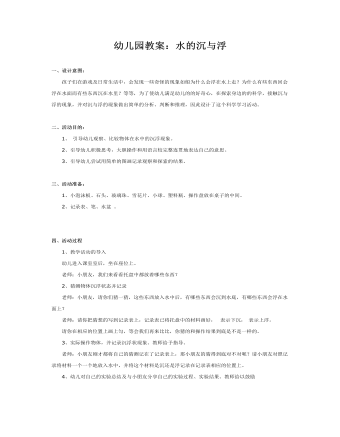
幼儿园教案:水的沉与浮
二、活动目的:1、引导幼儿观察、比较物体在水中的沉浮现象。2、引导幼儿积极思考,大胆操作和用语言较完整连贯地表达自己的意思。3、引导幼儿尝试用简单的图画记录观察和探索的结果。 三、活动准备:1、小泡沫板、石头、玻璃珠、雪花片、小球、塑料瓶、操作盘放在桌子的中间。2、记录表、笔、水盆。
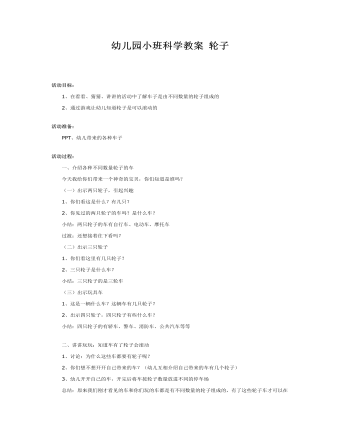
幼儿园小班科学教案 轮子
2、通过游戏让幼儿知道轮子是可以滚动的活动准备:PPT、幼儿带来的各种车子活动过程: 一、介绍各种不同数量轮子的车 今天我给你们带来一个神奇的宝贝,你们知道是谁吗? (一)出示两只轮子,引起兴趣1、你们看这是什么?有几只?2、你见过的两只轮子的车吗?是什么车? 小结:两只轮子的车有自行车、电动车、摩托车 过渡:还想接着往下看吗?
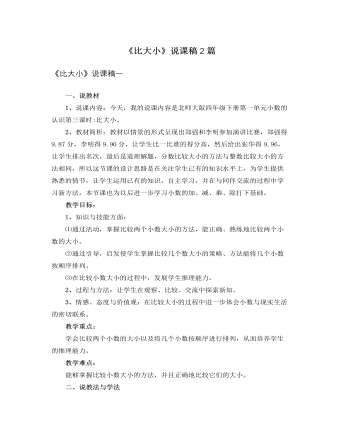
北师大版小学数学四年级下册《比大小》说课稿2篇
一、教材分析《歌手大赛》是北师大版材四年级下册第一单元《小数的意义和加减法》的最后一课,实质教学内容是小数的加减混合运算。它是在学生已经熟练掌握了整数的混合运算,认识了小数的意义和性质,掌握了用竖式计算小数加减法的基础上安排的教学内容,是数的运算中不可缺少的内容。教学目标:知识目标:结合具体情境,能正确进行小数加减混合运算,并能选择简单的方法进行计算。能解决简单的小数加减法的混合运算的实际问题,增强数学应用意识。能力目标:能熟练运用小数加减法,通过对“谁的总分高”的探究,让学生自己先估算,再组织学生独立探究,并在全班进行交流,增强学生的计算能力及解决实际问题的能力。情感目标:使学生在参与、思考、交流的过程中,体验获取知识的快乐。
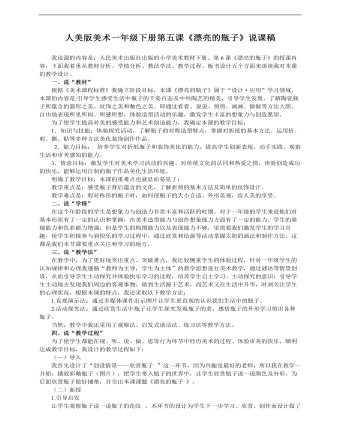
小学美术人美版一年级下册《漂亮的瓶子》说课稿
1.知识与技能:体验探究活动,了解瓶子的对称造型特点,掌握对折纸的基本方法。运用折、剪、撕、贴等多种方法美化装饰创作作品。 2.能力目标: 培养学生对折纸瓶子和装饰美化的能力,提高学生创新表现、动手实践、观察生活和审美感知的能力。3.情意目标:激发学生对美术学习活动的兴趣、对传统文化的认同和热爱之情,体验创造成功的快乐,能够运用自制的瓶子作品美化生活环境。明确了教学目标,本课的重难点也就显而易见了:教学重点是:感受瓶子背后蕴含的文化,了解折剪的基本方法及简单的纹饰设计。教学难点是:剪对称形的瓶子时,如何使瓶子的大小合适、外形美观,给人美的享受。
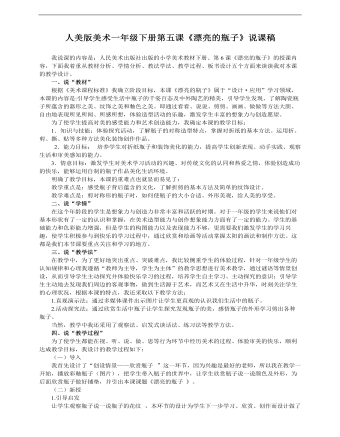
小学美术人美版一年级下册《6漂亮的瓶子》说课稿
1.知识与技能:体验探究活动,了解瓶子的对称造型特点,掌握对折纸的基本方法。运用折、剪、撕、贴等多种方法美化装饰创作作品。 2.能力目标: 培养学生对折纸瓶子和装饰美化的能力,提高学生创新表现、动手实践、观察生活和审美感知的能力。3.情意目标:激发学生对美术学习活动的兴趣、对传统文化的认同和热爱之情,体验创造成功的快乐,能够运用自制的瓶子作品美化生活环境。明确了教学目标,本课的重难点也就显而易见了:教学重点是:感受瓶子背后蕴含的文化,了解折剪的基本方法及简单的纹饰设计。教学难点是:剪对称形的瓶子时,如何使瓶子的大小合适、外形美观,给人美的享受。

人音版小学音乐三年级下册嘀哩嘀哩说课稿
艺术课程作为一门新课程,是在已有的音乐、美术分科基础上构建的一门新课程,从传统的分科教学转变为多门艺术学科的沟通和融合。本课是从音乐切入的艺术课,让学生在欣赏、节奏、歌唱、表演等一系列音乐活动中感受音乐,学习音乐,表现音乐。让孩子们在歌唱描述春天的歌曲中体验春天的美丽景色;并综合了音乐、美术、舞蹈等艺术形式和表现手法,全面地培养学生的综合能力,使艺术课堂教学呈现勃勃生机,充分反映了课程改革的新理念。二、说教材1.教材分析歌曲《嘀哩嘀哩》是一首深受孩子们喜爱的歌曲,它反映的是少年儿童通过观察大自然的变化,寻找春天的足迹、迎接春天的到来。它以儿童天真、活泼的语气歌唱美丽的春天,抒发心中无限欢乐的感情。《嘀哩嘀哩》又是学生非常熟悉的一首歌曲,有的学生已经会唱,他们对音乐的理解与把握也有一定的能力。针对这首歌曲,最主要的就是运用孩子们感兴趣的方式帮助学生准确的演唱歌曲“嘀哩哩嘀哩嘀哩哩”有难度的乐句。

